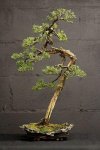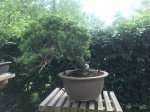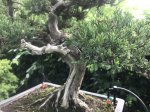Sit a San Jose next a nana procumbens and the difference is clear.
San Jose are more coarse. Like the one in the original post.
Nana procumbens get scale foliage here.
After reading through yet another thread full of pointless drama, I'm left wondering if maybe everyone is right.
I have a juniper that is afaik a JPN. Bought it from a bonsai nursery that I'm sure knows the difference. I've been working on it for 7 years, and never seen a single bit of scale foliage. I've seen others online complain that JPN develops scale foliage, and was always a bit confused by that. Now you've got me seriously wondering if maybe this is just a location-specific thing, and perhaps different people get different results in different locations with the same species.
Or perhaps the possibility of a mass mis-labeling is also plausible. Maybe everyone bought or saw a tree labeled juniper procumbens nana, and it either did or did not generate scale foliage. And based on that, many apparently formed an unassailable opinion.
But either way, I'm guessing everyone is probably right from their point of view, given the level of passion going into this discussion.
Those are at least two possible scenarios where both sides are correct. There are almost certainly others. It could even be a combination of things. Could even be the case that nobody fully knows for sure.
People really need to chill the hell out and stop being so attached to being right and proving the person with the counter-point wrong. Maybe everyone can learn a little something that way. I'm as curious to know the answer as everyone else, but I also know that I don't know for sure, so collecting evidence and/or consulting with experts to work it out seems so much better than throwing around absolute truths that seem to be anything but.
And outright telling people "YOU ARE WRONG" just seems so counter-productive to reasonable conversation, not to mention rude. Even if the other person
is wrong, all that does is escalate silly drama. From reading this thread, it seems far more likely that we're dealing with shades of grey here, and I think the conversation level would improve if we started from that perspective.
Here's how this thread reads to me in a nutshell:
A: "My nana has needles only". Therefore JPN has only needles.
B: "My nana has both. You clearly don't know what you're talking about."
A: "Wrong! You have clearly misidentified the tree."
B: "What are you an idiot? "
<drama, drama, drama, more bullshit drama>
C: "Well, I guess there are a number of possibilities ... mislabeling stock, growing differently in different zones, etc, etc"
An alternative:
A: "My nana has needles only". Therefore JPN has only needles.
B: "That's interesting. The ones I've bought and seen that were labeled JPN clearly had both."
A: "Yes, that is interesting. I wonder where the discrepancy lies?"
B: "Well, I guess there are a number of possibilities ... mislabeling stock, growing differently in different zones, etc, etc"
Both ways arrive at the same conclusion, but only one way causes a bunch of people to hate each other afterwards.
Sorry for the rant - I guess I'm sick of the stupid juvenile arguments I continuously see here lately. Can't we all just get along and discuss little trees without being jerks to one another?
Cheers.
~MM







